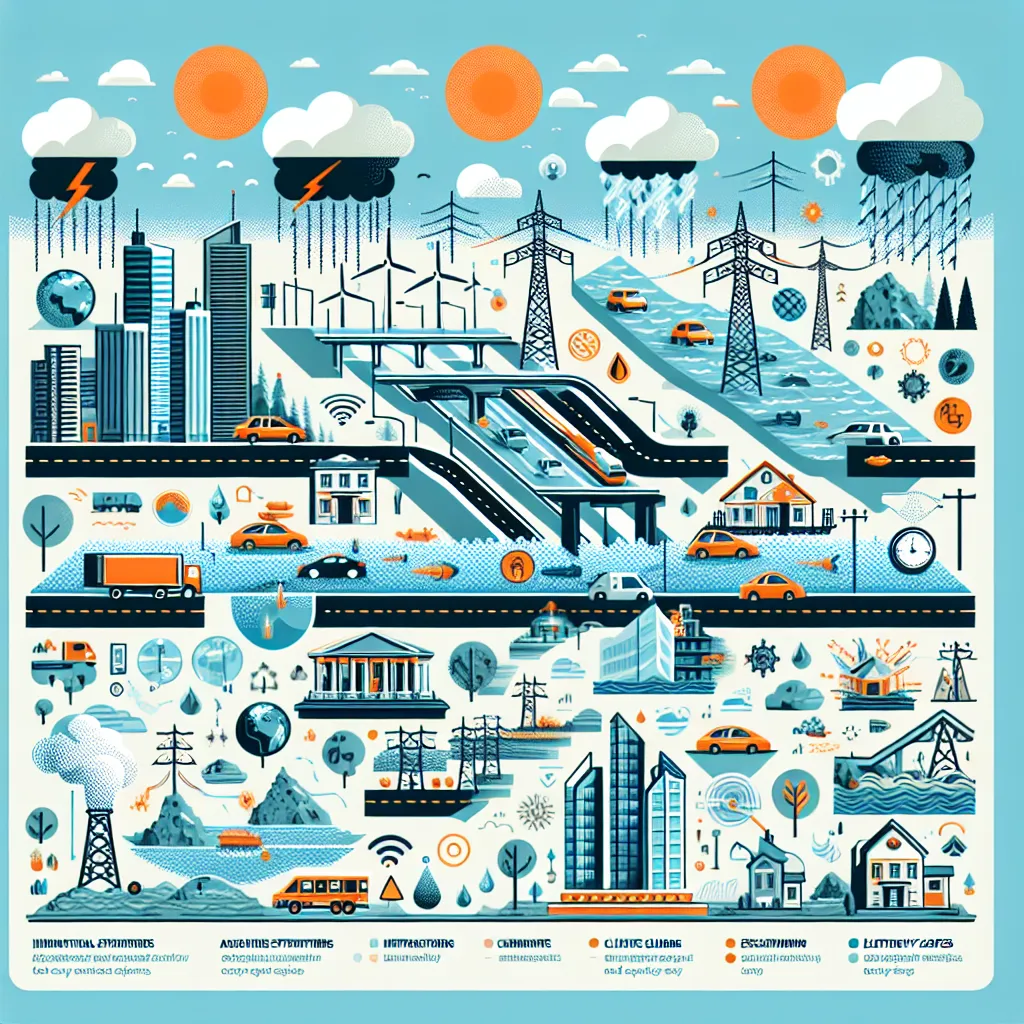The IELTS Reading section tests your ability to comprehend complex texts and answer questions accurately. Today, we’ll focus on a highly relevant topic: “Climate change’s impact on global infrastructure.” This subject has been increasingly prevalent in recent IELTS exams, reflecting its growing importance in global discussions. Given its current significance and the frequency of its appearance in past tests, it’s likely to remain a key topic in future IELTS exams. Let’s dive into a practice passage and questions to help you prepare for this critical subject.
 Climate change impact on infrastructure
Climate change impact on infrastructure
Reading Passage
Climate Change’s Growing Threat to Global Infrastructure
Climate change is no longer a distant threat but a present reality that is reshaping our world in profound ways. One of the most significant and costly impacts of this global phenomenon is its effect on infrastructure worldwide. From transportation networks to energy systems, water supplies to urban landscapes, the changing climate is challenging the resilience of the built environment that underpins modern society.
Rising sea levels pose a particular threat to coastal infrastructure. Major cities like Miami, Shanghai, and Jakarta are already grappling with increased flooding, which is damaging roads, compromising building foundations, and overwhelming drainage systems. In the United States alone, a report by the National Oceanic and Atmospheric Administration (NOAA) estimates that sea level rise could affect nearly $1 trillion worth of coastal property and infrastructure by 2050.
Extreme weather events, which are becoming more frequent and severe due to climate change, are another major concern. Hurricanes, typhoons, and intense rainstorms can devastate infrastructure in a matter of hours. The 2017 hurricane season in the Caribbean, which included the catastrophic Hurricane Maria, caused an estimated $282 billion in damages, much of it to critical infrastructure such as power grids, water systems, and transportation networks.
Heat waves also pose a significant challenge to infrastructure resilience. Prolonged high temperatures can cause roads to buckle, railway tracks to warp, and electrical systems to fail. During the 2019 European heat wave, for instance, Germany had to decrease speed limits on its autobahns as the extreme heat caused sections of the roadway to crack and lift.
Water infrastructure is particularly vulnerable to climate change impacts. Droughts can lead to water shortages and increased competition for limited resources, while floods can overwhelm water treatment facilities and contaminate drinking water supplies. In Australia, the Millennium Drought (1996-2010) led to severe water restrictions and necessitated massive investments in desalination plants and water recycling infrastructure.
The energy sector is also feeling the effects of climate change. Power plants, especially those reliant on water for cooling, are at risk during heat waves and droughts. In 2018, several nuclear power plants in Europe had to reduce output or shut down completely due to high water temperatures and low river levels. Additionally, the increasing frequency of wildfires poses a significant threat to power transmission lines, as evidenced by the devastating fires in California in recent years.
Adapting infrastructure to withstand these climate impacts is a monumental challenge that requires significant investment and innovative solutions. The Global Commission on Adaptation estimates that $1.8 trillion invested in adaptation measures could generate $7.1 trillion in total net benefits. These adaptations include everything from upgrading storm water systems and reinforcing coastal defenses to developing heat-resistant materials for construction.
Moreover, there’s a growing recognition that future infrastructure must not only be resilient to climate impacts but also contribute to mitigation efforts. This has led to an increased focus on green infrastructure and nature-based solutions. For instance, cities are increasingly incorporating green spaces and permeable surfaces to manage stormwater runoff and reduce urban heat island effects.
The challenge of climate change to global infrastructure is immense, but it also presents opportunities for innovation and sustainable development. As we rebuild and reinforce our infrastructure for a changing climate, we have the chance to create more resilient, efficient, and environmentally friendly systems that can serve as the backbone of a sustainable future.
Questions
True/False/Not Given
For questions 1-5, decide if the statements are True, False, or Not Given based on the information in the passage.
- Climate change is affecting infrastructure in both developed and developing countries.
- The United States is expected to lose $1 trillion worth of coastal property due to sea level rise by 2050.
- Hurricane Maria in 2017 was the most expensive natural disaster in Caribbean history.
- During the 2019 European heat wave, all German autobahns were closed due to damage.
- The Millennium Drought in Australia lasted for 14 years.
Multiple Choice
Choose the correct letter, A, B, C, or D.
-
According to the passage, which of the following is NOT mentioned as a direct impact of climate change on infrastructure?
A) Flooding of coastal areas
B) Damage to road surfaces
C) Increased air pollution in cities
D) Failure of electrical systems -
The passage suggests that future infrastructure development should:
A) Focus solely on resilience to climate impacts
B) Prioritize cost-effectiveness over sustainability
C) Combine resilience with contribution to mitigation efforts
D) Rely exclusively on traditional engineering solutions
Matching Headings
Match the following headings to paragraphs 3-7 in the passage. Choose the correct heading from the list below.
List of Headings:
I. The vulnerability of water systems
II. Coastal cities under threat
III. The energy sector’s climate challenges
IV. Extreme weather events and infrastructure damage
V. Heat waves and transportation infrastructure
VI. The cost of climate adaptation
VII. Green solutions for urban areas
- Paragraph 3: __
- Paragraph 4: __
- Paragraph 5: __
- Paragraph 6: __
Summary Completion
Complete the summary below using words from the box.
A) resilient B) adaptation C) sustainable D) mitigation
E) innovative F) green G) nature-based H) efficient
Addressing the impact of climate change on infrastructure requires significant investment in 12)__ measures. The Global Commission on Adaptation suggests that such investments could yield substantial net benefits. Future infrastructure development needs to focus on being 13)__ to climate impacts while also contributing to 14)__ efforts. This has led to an increased emphasis on 15)__ infrastructure and 16)__ solutions, which can help manage environmental challenges in urban areas.
Answer Key and Explanations
-
True – The passage mentions impacts on cities in various countries, including developed (e.g., Miami in the US) and developing (e.g., Jakarta in Indonesia) nations.
-
False – The passage states that “sea level rise could affect nearly $1 trillion worth of coastal property and infrastructure by 2050” in the US, not that it will definitely lose this amount.
-
Not Given – While the passage mentions the 2017 hurricane season’s significant damage, it doesn’t specify Hurricane Maria as the most expensive in Caribbean history.
-
False – The passage states that Germany had to “decrease speed limits on its autobahns,” not close them entirely.
-
Not Given – The passage mentions the Millennium Drought (1996-2010) but doesn’t explicitly state its duration as 14 years.
-
C – The passage doesn’t mention increased air pollution in cities as a direct impact of climate change on infrastructure.
-
C – The passage states, “future infrastructure must not only be resilient to climate impacts but also contribute to mitigation efforts.”
-
IV – This paragraph discusses the impact of extreme weather events like hurricanes on infrastructure.
-
V – This paragraph focuses on how heat waves affect transportation infrastructure like roads and railways.
-
I – This paragraph is about the vulnerability of water infrastructure to climate change impacts.
-
III – This paragraph discusses the challenges faced by the energy sector due to climate change.
-
B – “Adaptation” measures are discussed as necessary investments to address climate change impacts.
-
A – The passage emphasizes the need for infrastructure to be “resilient” to climate impacts.
-
D – The text mentions that future infrastructure should contribute to “mitigation” efforts.
-
F – “Green” infrastructure is mentioned as a focus for future development.
-
G – “Nature-based” solutions are mentioned alongside green infrastructure as approaches to manage environmental challenges.
Common Mistakes
-
Confusing “affect” with “effect”: Remember, “affect” is usually a verb meaning “to influence,” while “effect” is usually a noun meaning “result” or “consequence.”
-
Misinterpreting “Not Given” statements: If information isn’t explicitly stated in the passage, even if it seems logical, it should be marked as “Not Given.”
-
Overlooking qualifying words: Pay attention to words like “some,” “many,” “often,” which can change the meaning of a statement.
-
Falling for distractors in multiple-choice questions: Always refer back to the passage and choose the option that best matches the information given.
-
Mismatching headings: Ensure you understand the main idea of each paragraph before selecting a heading.
Vocabulary
- Resilience (noun): /rɪˈzɪliəns/ – The capacity to recover quickly from difficulties
- Grapple (verb): /ˈɡræpəl/ – To struggle or contend with
- Compromise (verb): /ˈkɒmprəmaɪz/ – To weaken or harm
- Devastate (verb): /ˈdevəsteɪt/ – To destroy or ruin
- Vulnerable (adjective): /ˈvʌlnərəbəl/ – Susceptible to physical or emotional harm
- Monumental (adjective): /ˌmɒnjʊˈmentəl/ – Very great in importance, extent, or size
Grammar Focus
Pay attention to the use of present perfect tense in the passage, e.g., “Climate change has become a present reality.” This tense is used to connect past events or states to the present.
Also, note the use of modal verbs to express possibility and prediction, such as “sea level rise could affect…” These are crucial for discussing future impacts and potential scenarios.
Tips for IELTS Reading Success
-
Practice active reading: Engage with the text by predicting content, asking questions, and summarizing main ideas.
-
Improve your time management: Allocate your time wisely between different question types and passages.
-
Expand your vocabulary: Regular reading on various topics can help you encounter and learn new words in context.
-
Develop your skimming and scanning skills: These are crucial for quickly locating specific information in the text.
-
Pay attention to transition words and phrases: These can help you understand the structure and flow of ideas in the passage.
By focusing on these areas and regularly practicing with passages on current global issues like climate change, you’ll be well-prepared for the IELTS Reading test. Remember, understanding complex texts on topics like the impact of climate change on global infrastructure not only helps in your IELTS preparation but also enhances your general knowledge, which is valuable for the other sections of the IELTS exam as well.
For more practice on related topics, you might find these articles helpful:
- Effects of Climate Change on Tourism
- Climate Change’s Impact on Urban Infrastructure
- Impacts of Renewable Energy on Energy Security
Keep practicing, and good luck with your IELTS preparation!


